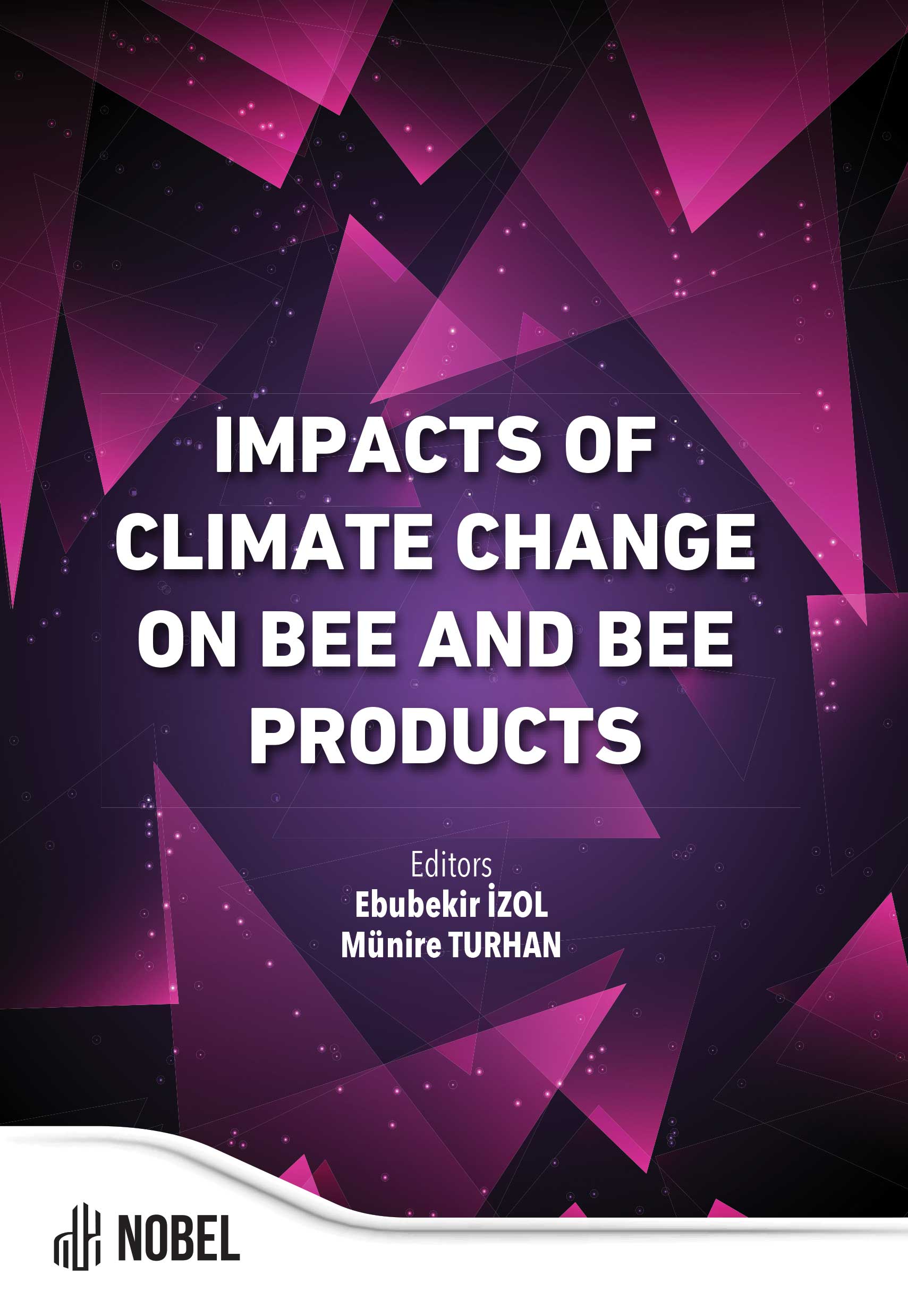Effect of Rainfall, Temperature and Humidity on Honey Yield
Munire Turhan (Author)
Release Date: 2024-04-09
Sustainable beekeeping requires addressing the honey bee family, beekeepers and environmental factors with a holistic approach. Producing high quality and healthy bee products such as honey, royal jelly, pollen and propolis is important for food quality and safety.
Media Type
Buy from
Price may vary by retailers
| Work Type | Book Chapter |
|---|---|
| Published in | Impacts of Climate Change on Bee and Bee Products |
| First Page | 95 |
| Last Page | 106 |
| DOI | https://doi.org/10.69860/nobel.9786053358978.6 |
| Page Count | 12 |
| Copyright Holder | Nobel Tıp Kitabevleri |
| License | https://nobelpub.com/publish-with-us/copyright-and-licensing |
Munire Turhan (Author)
Bingöl University
https://orcid.org/0000-0003-3373-1400
3Dr. Münire TURHAN works in the fields of beekeeping, bee breeding, queen bee production, pollination, bee product production and harvesting, bee product preservation methods, bee diseases and pests, and apitherapy. She is an expert in these fields. She has many scientific studies along with field studies in these fields.
İzol, E. (2023). Bazı Arı Ürünlerinin (Bal, Polen, Propolis, Arı Sütü ve Arı Ekmeği) LC-MS/MS ile Sekonder Metabolitlerinin ve Biyolojik Aktivitelerinin Belirlenmesi. Doktora tezi. Atatürk Üniversitesi Fen Bilimleri Enstitüsü, Erzurum.
İzol, E., Turhan, M. (2024). “Antioxidant Potential of Honey with Recent In-Vitro Studies”. 8. International Palandöken Scientific Studies Congress Book, p:300-307.
İzol, E., Gülçin, İ., Yılmaz, M.A. (2023). “Health Effects of Honey and Honey Sherbet with Spiritual and Scientific Sources”, In Functional Foods, ed. Haspolat Y.K., Kavak V., Asena M., Orient Publications, 89-95.
Anonim (2020b) Türkiye İstatistik Kurumu İstatistikleri. http://www.tuik. gov.tr/UstMenu.do?metod=katego rist (Erişim Tarihi: 01.03.2020).
Yapıcı, İ., İzol, E., Tarhan, A. (2023). “Significant Bioactive Components in Bee Products”, In Bee and Bee Products, ed. İzol E., Koçyiğit M., Haspolat Y.K., Orient Publications, 1-15.
İzol, E., & İzol, İ. 2022. “Arı Ürünlerinin Spektroskopik Yöntemlerle Metal Konsantrasyonlarının Belirlenmesi ve Çevreye Etkileri”, In Tarımsal Üretimde, Tarımsal Kirliliğin Ayak İzi, ed. Kökten K., İnci Ş., Iksad International Publishing House, 1, 209–230. ISBN: 978-625-8405-32-3.
Rader R, Reilly J, Bartomeus I, Winfree R (2013) Native bees buffer the negative ımpact of climate warming on honeybee pollination of watermelon crops. Global Change Biology 19: 3103-3110.
Nyunza G (2018) Antropogenic and climatic factors affecting honey production: the case of selected villages in manyoni district, Tanzania. Journal of Agricultural Biotechnology and Sustainable Development 10(3): 45-57.
Schweitzer P, Nombre I, Boussim JI (2013) Honey production for assessing the impact of climatic changes on vegetation. Tropicultura 31(2): 98- 102.
Langowska A, Zawilak M, Sparks TH, Glazaczow A, Tomkins PW, Tryjanowski P (2016) Long-term effect of temperature on honey yield and honeybee phenology. Int J Biometeorol. 61(6): 1125-1132.
Maria BO, Ikutal A, Agbachom EE, Ubi GM (2019) Strategies for mitigating climate change effect on honey bee productivity in Southern Nigeria. Annual Research & Review in Biology 1-9
Topal E, Özsoy N, Şahinler N (2016) Küresel ısınma ve arıcılığın geleceği. Mustafa Kemal Üniversitesi Ziraat Fakültesi Dergisi 21(1): 112-120.
Şahin M, Topal E, Özsoy N, Altunoğlu E (2015) İklim değişikliğinin meyvecilik ve arıcılık üzerine etkileri. Anadolu Doğa Bilimleri Dergisi 6(2): 147-154.
Topal E, Yücel B, Yıldızdal İ, Takma Ç, Aydın M, Karaca Ü (2017) Kiraz tozlaşmasında bal arısı (Apis mellifera L.) ve bombus arısının (Bombus terrestris) kimi davranış özelliklerinin ve çevresel sıcaklık değişiminin bitki fenolojisi ile verim üzerine etkileri. Hayvansal Üretim 58(2):24-33.
Karakaş G, Bal HSG (2019) The relationship between honey yield and environmental pollutants in Turkey. Turkish Journal of Agriculture 7(11): 2018-2024.
Külünk İ (2018) Türkiye’de ekonomik büyüme ve karbon salınımı ilişkisi: Engle-Granger eş bütünleşme analizi (1960-2013). Yönetim ve Ekonomi Araştırmaları Dergisi 16(1): 193-205.
Anonim (2020c) Meteoroloji Genel Müdürlüğü. https://mgm.gov.tr/ iklim/iklim-raporlari.aspx (Erişim Tarihi: 08.12.2020).
İzol, E. (2021). “Yenilikçi Arı Ürünleri ve Biyolojik Önemleri.” In Tarım Uygulamalarında Yenilikçi Yaklaşımlar, ed. İnci H., Kökten K., Iksad Publications, 77–116.
Anonymous (2021) Honey Production Statistics. http://www.fao.org/faostat/ en/#data/QL (Erişim Tarihi: 17.01.2021).
Abrol DP, Shankar U, Nitin KS, Gowda GB (2016) Honeybees and beekeeping: The global scenario. In Arthropod Diversity and Conservation in the Tropics and Sub-tropics Springer, Singapore. pp. 345-372.
Slathia I, Tripathi NK (2016) Impact of climate change on honey-bee populations and diseases. Published by Research Trend, Website: www. biobulletin. com, 2(1): 40-42.
Patır S, Seçkin MZ (2020) Türkiye’de kovan tiplerinin bal üretimine etkisinin eşbütünleşme analiz yöntemi ile belirlenmesi. Fırat Üniversitesi Uluslararası İktisadi ve İdari Bilimler Dergisi 4(2): 81-92.
Duru S, Parlakay O (2021). “Türkiye’de iklim değişikliğinin bal verimine etkisi: ARDL sınır testi yaklaşımı” Mustafa Kemal Üniversitesi Tarım Bilimleri Dergisi 26 (3):791-800, 2021 (Mustafa Kemal University Journal of Agricultural Sciences 26 (3):791-800, 2021) e-ISSN: 2667-7733
Bozkurt Z (2019). “Bal Arılarında Refah”. Bahri Dağdaş Hayvancılık Araştırma Dergisi Journal of Bahri Dagdas Animal Research 8 (2):96-108 e-ISSN: 2687-3745, www.arastirma.tarim.gov.tr/bahridagdas
| onix_3.0::thoth | Thoth ONIX 3.0 |
|---|---|
| onix_3.0::project_muse | Project MUSE ONIX 3.0 |
| onix_3.0::oapen | OAPEN ONIX 3.0 |
| onix_3.0::jstor | JSTOR ONIX 3.0 |
| onix_3.0::google_books | Google Books ONIX 3.0 |
| onix_3.0::overdrive | OverDrive ONIX 3.0 |
| onix_2.1::ebsco_host | EBSCO Host ONIX 2.1 |
| csv::thoth | Thoth CSV |
| json::thoth | Thoth JSON |
| kbart::oclc | OCLC KBART |
| bibtex::thoth | Thoth BibTeX |
| doideposit::crossref | CrossRef DOI deposit |
| onix_2.1::proquest_ebrary | ProQuest Ebrary ONIX 2.1 |
| marc21record::thoth | Thoth MARC 21 Record |
| marc21markup::thoth | Thoth MARC 21 Markup |
| marc21xml::thoth | Thoth MARC 21 XML |

